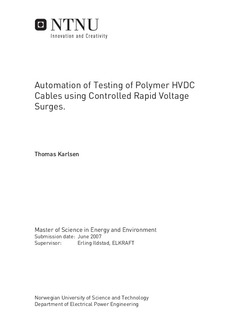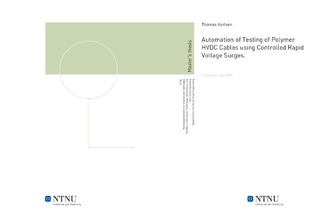| dc.contributor.advisor | Ildstad, Erling | nb_NO |
| dc.contributor.author | Karlsen, Thomas | nb_NO |
| dc.date.accessioned | 2014-12-19T13:50:56Z | |
| dc.date.available | 2014-12-19T13:50:56Z | |
| dc.date.created | 2010-09-03 | nb_NO |
| dc.date.issued | 2007 | nb_NO |
| dc.identifier | 347493 | nb_NO |
| dc.identifier | ntnudaim:3536 | nb_NO |
| dc.identifier.uri | http://hdl.handle.net/11250/256487 | |
| dc.description.abstract | This report aims to describe the work done in order to develop a solution for automation of failure detection and performance of rapid voltage surges. The automated system was developed with basis in the experimental circuit developed at NTNU/SINTEF. The experimental circuit relied on manually performing rapid voltage surges and detecting cable failure. Meaning that unknown variables may have been introduced due to the inequality of each grounding. The realized automation system consisted of two parts. The first part was a switch that was able to withstand the voltage applied and able to perform the rapid voltage surges. The second part was a program that controlled the switch and regularly monitored the condition of the cable object, indicating failure when electrical treeing had caused breakdown in the cable insulation. Two solutions for switches were examined. One switch utilized an arm moving between two electrodes for grounding the objects, using textile bakelite as insulation and support frame for the electrodes. The other switch utilized a sphere gap with air as insulation and an electric field strength close to the breakdown strengt of the air. Groundings in the sphere gap switch were performed using a striker to greatly enhance the electric field and cause a spark between the spheres, causing a transition from a highly insulating state to a highly conductive state. As the experimental circuit had a large current limiting resistance, the experimental circuit was sensitive to leakage currents as they set up a voltage over the resistance, instead of the cable objects. Leakage currents in the switches were examined and it was found that the arm switch had leakage current unacceptable for use in the experiment. Similarly, leakage currents in the sphere gap switch were examined and found to be acceptable for use in the experiment. The behaviour of cable objects that, due to electrical treeing had developed insulation failure was examined and measurement parameters for detecting cable failure were found. These parameters were implemented using LabView as a platform for creating a a control program and interface to the instruments connected to the switch. Having fully created the automated system, the system was used in testing cable objects and was found able to inflict and detect a cable failure due to electrical treeing. However, compared to previous results, a lower number of groundings were needed, which may indicate that the introduction of the sphere gap switch has altered the circuit in a manner such that new results will differ from former results. | nb_NO |
| dc.language | eng | nb_NO |
| dc.publisher | Institutt for elkraftteknikk | nb_NO |
| dc.subject | ntnudaim | no_NO |
| dc.subject | SIE5 energi og miljø | no_NO |
| dc.subject | Elektrisk energiteknikk | no_NO |
| dc.title | Automation of Testing of Polymer HVDC Cables using Controlled Rapid Voltage Surges. | nb_NO |
| dc.type | Master thesis | nb_NO |
| dc.source.pagenumber | 57 | nb_NO |
| dc.contributor.department | Norges teknisk-naturvitenskapelige universitet, Fakultet for informasjonsteknologi, matematikk og elektroteknikk, Institutt for elkraftteknikk | nb_NO |

